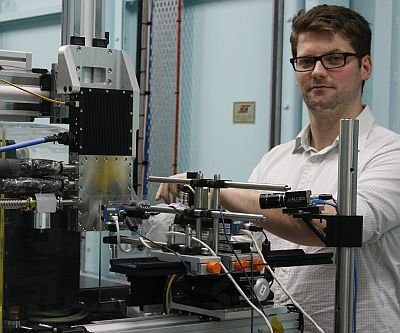Three early-career synchrotron researchers have been awarded prestigious Victorian fellowships.
In October 2013, Dr Simon James from the Australian Synchrotron received a Victoria Fellowship to attend international workshops and conferences to develop his ability to the use the Australian Synchrotron to as a tool to understand the pathogenesis of Alzheimer’s disease.
 Simon is a bio-inorganic chemist, with a particular interest in how the metabolism of Fe, Cu and Zn changes as we age. As a postdoctoral fellow on the x-ray fluorescence microscopy (XFM) beamline his research involves investigating how the damaging build-up of the amyloid beta peptide in the brains of Alzheimer’s sufferers is influenced by the peptide’s ability to interact with essential biological co-factors like copper and zinc ions. So far no-one has managed to persuade the peptide to form crystals that would enable researchers to fully characterise its structure. However, Simon believes that a technique called ‘x-ray absorption near-edge structure’ (XANES) could help to identify the dangerous chemistry that results from the peptide’s interaction(s) with copper and zinc do so within intact tissue without needing to know the full structure.
Simon is a bio-inorganic chemist, with a particular interest in how the metabolism of Fe, Cu and Zn changes as we age. As a postdoctoral fellow on the x-ray fluorescence microscopy (XFM) beamline his research involves investigating how the damaging build-up of the amyloid beta peptide in the brains of Alzheimer’s sufferers is influenced by the peptide’s ability to interact with essential biological co-factors like copper and zinc ions. So far no-one has managed to persuade the peptide to form crystals that would enable researchers to fully characterise its structure. However, Simon believes that a technique called ‘x-ray absorption near-edge structure’ (XANES) could help to identify the dangerous chemistry that results from the peptide’s interaction(s) with copper and zinc do so within intact tissue without needing to know the full structure.
Photo at right: Simon James (AS) is developing new ways to extract information from the XFM beamline.
One-third to one-half of all proteins have a metal co-factor involved in their activity. The Synchrotron’s XFM beamline can map which elements are present in a sample, along with their locations and chemical form. The beamline can handle intact biological samples, enabling researchers to watch how the environment around a metal ion changes during the course of a reaction, in the native environment. For example, this could mean looking at the small changes in bond length between the iron in haemoglobin and the various nitrogen and oxygen atoms closest to the metal centre. This information helps researchers understand exactly how the iron contributes to the functioning of the protein.
XANES can provide very complementary information to a powerful technique called ‘extended x-ray fine structure’ (EXAFS), which is available in another part of the Australian Synchrotron, the x-ray absorption spectroscopy (XAS) beamline. EXAFS provides information on the precise chemical species of elements in many different kinds of samples, but it would typically take far too long to collect such data at the XFM beamline. Although XANES is less well developed because its theoretical framework is less well understood, researchers are increasingly looking to use XANES on the XFM beamline because of its potential to provide valuable information on chemical speciation.
Simon will use his Victoria Fellowship to attend a summer school on EXAFS at the SLAC National Accelerator Laboratory at Stanford University in California. He plans to use new knowledge and skills gained from the course to develop ways to extract similar information from XANES on the XFM beamline.
Synchrotron user Dr Nishar Hameed from Deakin University received a Victoria Fellowship to develop highly sensitive medical imaging agents which diagnose and distinguish diseased tissue from normal tissue and provide information on a disease state and monitor the effect of a treatment. Nishar has used small angle x-ray scattering (SAXS) techniques at the Australian Synchrotron.
In September 2013, Dr Wye Khay Fong from Monash University’s Institute of Pharmaceutical Sciences (MIPS) became one of six early-career researchers to receive a Victorian Postdoctoral Research Fellowship. These fellowships enable recipients to study overseas for up to two years and then spend 12 months working with their host organisations in Victoria. Khay will spend two years working at ETH Zurich, where she will focus on enzyme-responsive nanomaterials with applications in disease detection and treatment. Khay made extensive use of the small angle x-ray scattering (SAXS) beamline at the Australian Synchrotron in her PhD studies with Dr Ben Boyd at MIPS.
